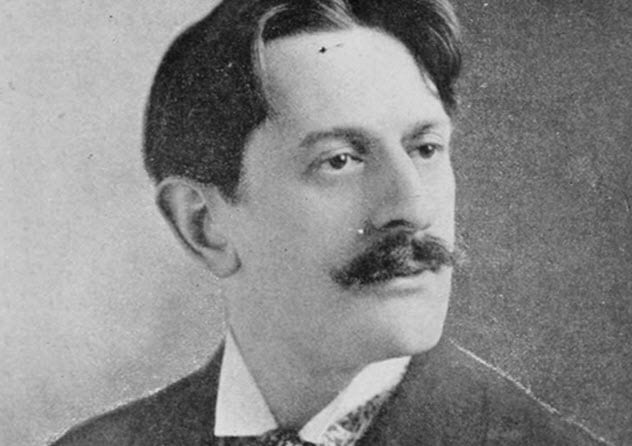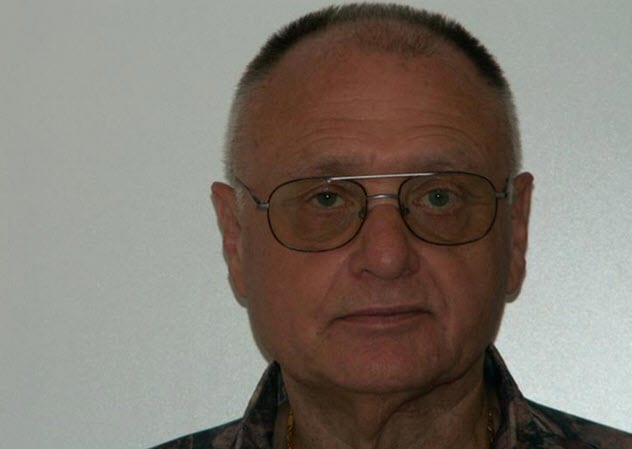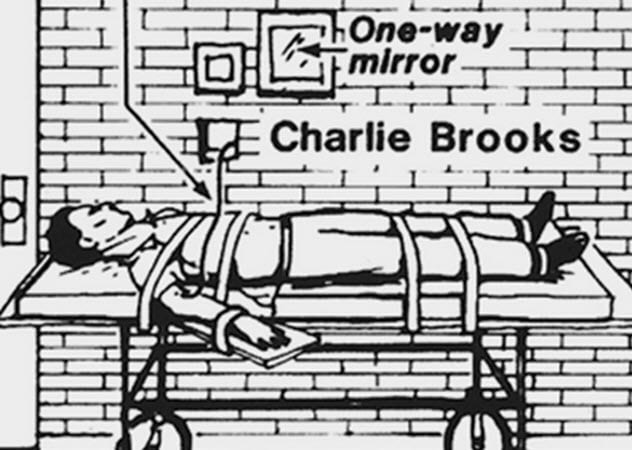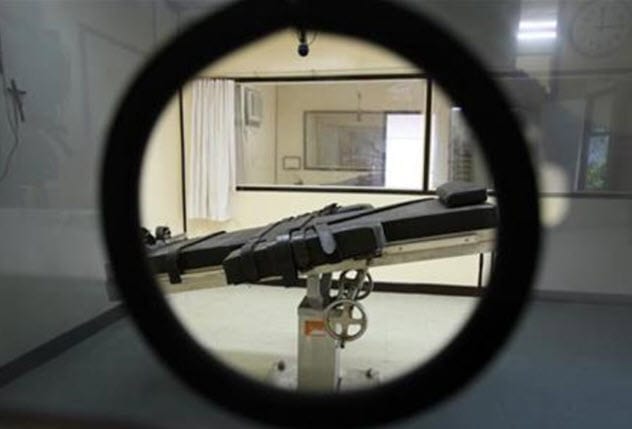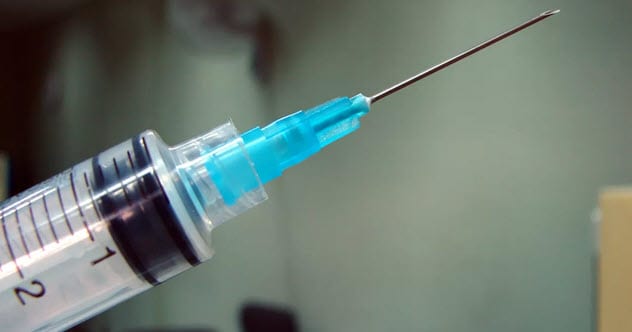The lethal injection was first introduced in the 1970s in the United States and, until very recently, has been the ready answer for those sentenced to death. It spread to several countries and is widely regarded as the best method of execution available. Maybe it is, but recent research has raised the question: Is the injection truly painless? And, if not, what can replace it?
10 A More Humane Execution
The initial proposal for lethal injections came during the Enlightenment when a humane method of execution was highly sought after. The first inklings of the idea can be found in the work of French historian Robert Muchembled, who collected accounts of the changes in the behavior of execution attendees from the 15th to the 18th centuries. At first, crowds jeered and celebrated the justice that they perceived to be done. The more brutal and painful, the better. Toward the end of the 18th century, the executions took on a much more somber tone. Nuns would follow the accused while sprinkling holy water, crying, and assuring the doomed person of the forgiveness that awaited them. In the 1790s, a new method was developed in France with the hopes of bringing some humanity to the practice of execution: the guillotine. Unfortunately, it was found very shortly afterward that a person’s head remained conscious for several seconds after death. Many quickly packed away their guillotines and looked for more compassionate means of execution.[1] Then, in 1888, New York doctor Julius Mount Bleyer suggested that a lethal injection would bring about a swift and painless end. He was ignored for two reasons. First, no one in medicine wanted the recently debuted hypodermic needle associated with death. Second, electricity was very new to the public and everyone was fascinated by it. The proponents of electricity, including Thomas Edison, had the masses believing that it would usher in a new utopia of convenience. It could and did, but people had started to think that their new friend electricity could do no wrong. The cult of electricity somehow convinced everyone that it was a much more humane way to die than dying while asleep. A few decades of victims convulsing and catching fire would change that, but hindsight is always 20/20.
9 Nazis Give Everything A Bad Reputation
Another reason that the lethal injection wasn’t adopted sooner may be its association with the Nazi regime. Although the gas chamber carries the most enduring mark as the Nazis’ preferred method of genocide, the lethal injection was an early favorite. Needless to say, the Nazi scientists and doctors weren’t concerned with providing a humane death. They carried out experiments on the disabled and ill using a variety of drugs injected into a variety of places. The most effective method that they found was to inject phenol, a highly toxic and corrosive chemical, directly into a person’s heart. Exactly what Nazi scientists meant by “most effective” is left up to our horrified imaginations. Hopefully, they meant fast. The program of systematically murdering the mentally and physically handicapped via gas chamber, injection, or even starvation was referred to as T-4. It began early on in 1939 and became the model for the genocide that was to follow in the 1940s.[2] It started with encouraging doctors to neglect patients deemed “unworthy of life” so that they would starve. It ended with patients being shipped by the thousands to killing centers. The international discovery of the horrors that had occurred in Nazi Germany caused executions by gas to fall out of favor and likely offset the adoption of lethal injection by a few decades. The British Royal Commission on Capital Punishment reported in 1954 that neither electrocution nor gas chamber was more humane than hanging. The commission took a moment at the end of their statement to note that lethal injection was definitely not ready but should be looked into as science advanced.
8 Chapman’s Protocol
It wasn’t until 1977 that an Oklahoma medical examiner named Jay Chapman would propose a specific formula for lethal injections to ensure a more humane death. Where Bleyer had been a doctor with experience in administering medicine via injection, Chapman was a forensic pathologist. However, Chapman’s timing was better. The public still associated death by gas with the Nazi regime, and electrocutions had proven to be visibly inhumane. Those executed by electric chair would sometimes catch fire, and witnesses were often shocked by how difficult that was to watch. So, when Chapman appeared with his suggestion of a three-drug protocol, the judicial system and public were more than ready to hear about it. The protocol was designed so that condemned prisoners were first numbed, then paralyzed, and finally killed. It’s important to note that prisoners could have simply been put to death with barbiturates, which would have ensured a painless death. We’ve often heard that the dose makes the poison, and this holds true for this drug. A small dose is often prescribed for insomnia or seizures. A medium dose can be used to keep a patient asleep during surgery. A large dose will slow brain function so thoroughly that autonomic functions like breathing just stop. This is the method used to put down a suffering animal, which is the sole reason that it was rejected for use on humans. The painless sleep option was deemed undignified.[3]
7 The First Execution
Chapman’s Protocol was imagined and developed in Oklahoma, but Texas was the first to use it. Charles Brooks Jr. was the first person to earn the dubious honor of testing Chapman’s idea. He was convicted of the murder of auto mechanic David Gregory after going for a test drive at the used car lot where Gregory worked. Gregory was found later that night tied up and shot in the head in a motel room. Brooks and his partner in crime, Woodie Loudres, were both convicted of the murder because no one could say for certain who fired the shot. However, Loudres managed to get his sentence reduced. Brooks did not. Of course, lethal injection was thought to be more humane. Brooks said that he could calm himself down if he thought of it as going in for surgery, something that he had experienced in the past due to bullet wounds. But no one truly knew what would happen to Brooks when he was injected. It had never been done before. Dick Reavis, a journalist with Texas Monthly, made an agreement with Brooks leading up to his execution date. They would confirm the agreement every single time they met. When Brooks went to be injected, he would shake his head back and forth if he suffered any pain. When the time did come, Brooks slowly turned his head from one side to the other and then up and back to one side. Reavis was never entirely certain if this was their signal. Also, it isn’t clear how much Brooks would have been able to move, given the paralytic that was administered to him.[4]
6 The Magic Three
The three drugs developed by Chapman that were injected into Brooks on the fatal day were the same drugs used to put people under for surgery. Chapman would later describe it as anesthesiology taken to the extreme. For that reason, he had anesthesiologist Stanley Deutsch review his proposal before it went public. An unnamed toxicologist was also consulted during the research phase. As determined by the three doctors, if the drugs were administered correctly, the prisoner should feel no pain and be completely unaware of what was happening after the first drug was absorbed. That drug was sodium thiopental, a barbiturate that could have done the job on its own in a high enough dose. Its purpose in the protocol was to put the prisoner into a deep sleep within 20 seconds or less. Pancuronium bromide, the second drug in the protocol, was a muscle relaxant given in a high dose. Its purpose was to stop the prisoner from thrashing around when the third drug was administered. It could also potentially cause death on its own as a high dose was known to stop a person from breathing.[5] The final drug was potassium chloride, which causes immediate cardiac arrest. When done properly, the whole protocol takes only five minutes to administer and the prisoner should be dead only two minutes after the final injection.
5 International Reception
At its home in the United States, the lethal injection enjoyed a widespread acceptance. As of March 13, 2019, all 30 states that allow capital punishment do so by injection. As of 2009, the 936 of 1,107 US prisoners executed since 1977 have been killed this way. Since 2000, only five inmates have been executed any other way, which was by electric chair. Utah still has a firing squad on the books which has been chosen by only two prisoners since 1977. Similarly, Washington has hanged three and Arizona has gassed 11. These methods of execution have been steadily phased out in the same way that 20 states have abandoned the death penalty altogether. Internationally, executions are as unique as the countries in which they occur. Hanging is by far the most common method of execution worldwide, likely because it is fast when done well and relatively cheap to carry out. The next most common is the firing squad and then the decidedly less humane stoning. However, many countries have adopted lethal injection. China, which executes roughly 10,000 people a year, has mobilized the practice. Prisoners can be put to death in a prison or in a death van. These are specially adapted ambulances that can travel to remote areas for quick and easy executions.[6] Many other countries adopted the injection in the 1990s. Taiwan, the first to legalize lethal injection after the United States, has never used it. Guatemala adopted the practice but stopped in 2000 when a televised execution was botched. Viewers sat horrified as the condemned convulsed.
4 A More Humane Torture
Even as the three-drug lethal injection spread to nations around the world, there still wasn’t any definitive proof that the procedure was painless or humane. Brooks had shaken his head when injected, maybe attempting to signal Reavis that he was in pain. Maybe he was simply convulsing mindlessly before the paralysis kicked in. We will never know if a well-carried-out injection causes pain because no one survives to tell us. Chapman scoffed at the idea of testing the protocol to see if it was painless. He said that the only way he could see to do that was to start at an inhumane dosage and work your way up, quizzing the surviving inmates along the way. It would be barbaric. But researchers in Florida and Virginia have found a less brutal way to test the injections. They simply test the levels of the drugs found in the bodies after death. Their work suggests that as many as 90 percent of prisoners subjected to the lethal injection do not have enough anesthetic in their system. Forty percent are believed to have been conscious, leaving them to experience an extreme burning sensation all over, muscle cramps, asphyxiation, and eventual cardiac arrest. All of this would occur when a person is at least partially paralyzed and unable to tell anyone that he is awake.[7] Some medical professionals believe that this is caused by too low a dose of sodium thiopental, usually only 2–3 grams. Inmates vary in size, and most have elevated levels of adrenaline when they go to their deaths. This means that a larger dose is needed to combat that.
3 The Cost Of Failure
Even if lethal injections were totally painless when carried out correctly, they are rarely done right. Doctors and nurses are often barred from participating in any part of an execution by their code of ethics. Some do, but their work is frowned upon, to put it mildly. Still, some doctors won’t even comment on the practice. This means that technicians with no formal training in the complexities of anesthesiology tend to administer the three shots. Any mistakes could result in a botched execution. The inmate will suffer unnecessarily if the technician cannot properly insert the needle, mixes up the shots, or injects too little of a chemical. These mistakes are quite common. In Oklahoma, an IV that was meant to go into the femoral artery of Clayton Lockett instead emptied just under the skin. He finally died after 43 minutes of extreme pain. In Georgia, technicians have had particular trouble inserting the IV as well. One technician gave up after an hour of searching for a suitable vein, which sounds like torture in and of itself. In another case, a 72-year-old had an IV inserted near his groin after his arms couldn’t be made to offer a vein. In Ohio, Dennis McGuire was executed using a controversial drug combination that left him gasping and struggling for 26 minutes.[8] For reference, the United Nations condemns any execution method that leaves its victim suffering for more than 10 minutes.
2 The Cost Of Success
Although we’ve discussed the ramifications of an execution on the condemned and witnesses, there is also often suffering for those who carry out the execution. Firing squads traditionally require that at least one gun contains a blank so that each executioner may feel that he didn’t kill the prisoner. Hangings and guillotines remove the executioners by small degrees from the executed. They pull a lever or sever a rope, and gravity does the rest for them. Even a stoning is an execution method that spreads the blame among everyone who throws a stone. Frank Thompson described the process of carrying out the first lethal injection in Oregon during an interview with Criminal‘s Phoebe Judge. Thompson was given the responsibility of researching how other states, like Texas and Arkansas, did their executions and putting together a team to carry out the procedure. He pulled from the prison staff’s population of military veterans, thinking that they would be more capable of killing and less affected by it. They practiced the procedure extensively, doing everything over and over to perfect it without administering the actual chemicals. Every member of the team, including Thompson, took turns being strapped to the gurney. Thompson’s team still was not ready for the emotional toll of the execution, which went perfectly according to plan. Thompson recalled telling the media the time of death and then returning to his office. For all of his team’s preparations, they didn’t have any protocol whatsoever for the hours after an injection. He didn’t know what to do with himself. Instead of relief, he felt only emptiness. He wasn’t the only one to feel that way. Some of his staff left the team, saying that they could never participate in another execution. Thompson has since dedicated himself to the abolition of the death penalty. He puts forth a unique argument that the death penalty only creates more victims by putting those in charge of keeping the peace and safeguarding life in the difficult position of taking life. If we are going to keep the death penalty, he asks why we do not randomly select and train executioners the same way that we randomly select jurors. Jurors, at least, are involved in the decision to assign the death penalty. Executioners only carry it out.[9]
1 How Will We Execute Next
Amid complaints about lethal injection from all sides, states that continue to administer the death penalty are attempting to find the next humane execution method. Oklahoma, the state where Chapman’s protocol was developed, has decided to go back to using gas. They’re taking their inspiration from the Final Exit Network which instructs people with painful terminal illnesses on how to commit voluntary suicide painlessly using inert gas. Initially, the favorite gas was helium, but its manufacturers started to mix oxygen into the tanks to stop the suicides. Now the favorite is nitrogen. This is the gas that Oklahoma is investigating for future executions. Some protest that there isn’t any scientific testing or proof of how painless nitrogen gas is, but Janis Landis, the Final Exit Network’s president, says that the science behind inert gas inhalation is solid. Any inert gas can be breathed without experiencing the painful choking and gasping brought on by other gases.[10] There is no oxygen hunger, which is the panic that occurs when a person experiences a buildup of carbon dioxide from being unable to exhale. Without that, the lack of oxygen becomes somewhat euphoric before a person dies, usually after only four minutes. Since the experience is euphoric, there’s no thrashing and no need for a paralytic. Unlike the lethal injection, anyone watching this style of execution will be able to tell immediately if the subject is in pain. Renee is an Atlanta-based graphic designer and writer.
